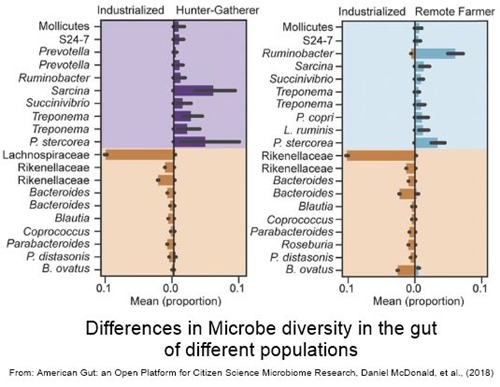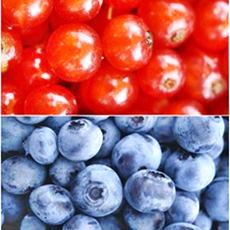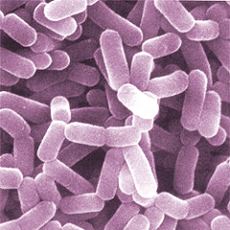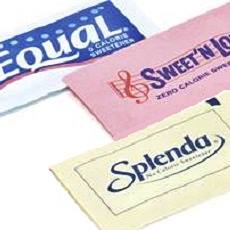Gut Microbiome and Diet
Your diet affects your gut microbes
Fact Checked
×All the content published in our website is fact checked to validate its accuracy.
Visit our guidelines web page to learn more about our strict processes regarding how we review our content's sources: reliable and reputable journals, media websites, universities, colleges, organizations, and professionals.
Our articles are based on scientific evidence, and the references are included in its footnotes, which are clickable links to sound scientific papers.
First published: 29. Dec.2018
Healthy Gut Bacteria
In this article, we will explore the relationship between diet and gut microbiome diversity.
The microorganisms (bacteria, fungi, archaea, and virus) that live in your gut (known as gut microbiome or GM), play an important role in keeping you healthy.
Microbiomes with more diversity are associated with better health, and the loss of species' variety is a sign of disease.
Many factors can disrupt the diversity of gut bacteria, fungi, and archaea, and diet is the most important one.

References and Further Reading
(1) Heiman M. and Greenway F., (2016). A healthy gastrointestinal microbiome is dependent on dietary diversity. Mol Metab. 2016 Mar 5;5(5):317-320
(2) Moszak, M., Szulinska, M., & Bogdanski, P. (2020). You Are What You Eat-The Relationship between Diet, Microbiota, and Metabolic Disorders-A Review. Nutrients, 12(4), 1096. https://doi.org/10.3390/nu12041096
(3) McDonald D. et al. (2018). American Gut: an Open Platform for Citizen Science Microbiome Research. Systems, Journal of the American Society for Microbiology, May 15, 2018. DOI: 10.1128/mSystems.00031-18
(4) Hoffmann C, et al. (2013). Archaea and Fungi of the Human Gut Microbiome: Correlations with Diet and Bacterial Residents. PLoS ONE 8(6): e66019
(5) Mbakwa CA., et al., (2015). Gut colonization with methanobrevibacter smithii is associated with childhood weight development. Obesity (Silver Spring). 2015 Dec;23(12):2508-16. doi: 10.1002/oby.21266. Epub 2015 Nov 2
(6) Ruchi Mathur et al., (2013). Intestinal Methanobrevibacter smithii but Not Total Bacteria Is Related to Diet-Induced Weight Gain in Rats. Obesity 21(4):748-754. April 2013 doi: 10.1002/oby.20277
(7) Valdes A., Walter J., Segal E., and Spector T., (2018). Role of the gut microbiota in nutrition and health. BMJ 2018; 361 doi: https://doi.org/10.1136/bmj.k2179 (Published 13 June 2018)
(8) Jha AR, Davenport ER, Gautam Y, Bhandari D, Tandukar S, Ng KM, et al. (2018). Gut microbiome transition across a lifestyle gradient in Himalaya. PLoS Biol 16(11): e2005396. https://doi.org/10.1371/journal.pbio.2005396
(9) Tian-Xing Liu, Hai-Tao Niu, and Shu-Yang Zhang, (2015). Intestinal Microbiota Metabolism and Atherosclerosis. Chin Med J (Engl). 2015 Oct 20; 128(20): 2805-2811. doi: 10.4103/0366-6999.167362
(10) Aziz T, Hussain N, Hameed Z, Lin L., (2020). Elucidating the role of diet in maintaining gut health to reduce the risk of obesity, cardiovascular and other age-related inflammatory diseases: recent challenges and future recommendations.Gut Microbes. 2024 Jan-Dec;16(1):2297864. doi: 10.1080/19490976.2023.2297864. Epub 2024 Jan 4. PMID: 38174551
(11) Petersen KS, Anderson S, Chen See JR, Leister J, Kris-Etherton PM, Lamendella R., (2022). Herbs and Spices Modulate Gut Bacterial Composition in Adults at Risk for CVD: Results of a Prespecified Exploratory Analysis from a Randomized, Crossover, Controlled-Feeding Study. J Nutr. 2022 Nov;152(11):2461-2470. doi: 10.1093/jn/nxac201. Epub 2022 Sep 2. PMID: 36774112
About this Article
Gut Microbiome and Diet, A. Whittall
©2024 Fit-and-Well.com. First Published: 29.Dec.2018. Updated 13.Nov.2024. Update scheduled for 16.Nov.2027. https://www.fit-and-well.com/diet-food/gut-microbiome-and-diet.html
Tags: microbiome, diet, Candida albicans, fungal, mycobiome, probiotics, yogurt






